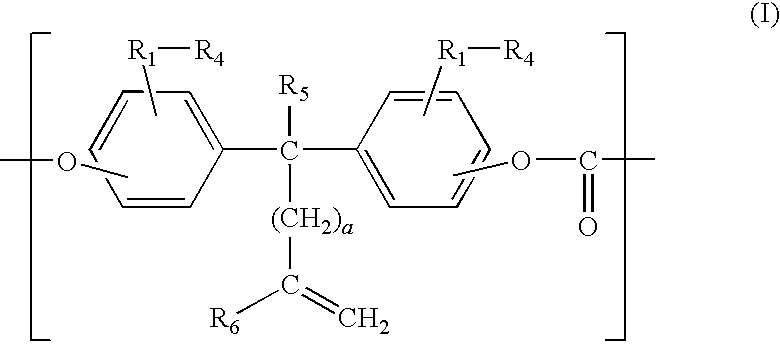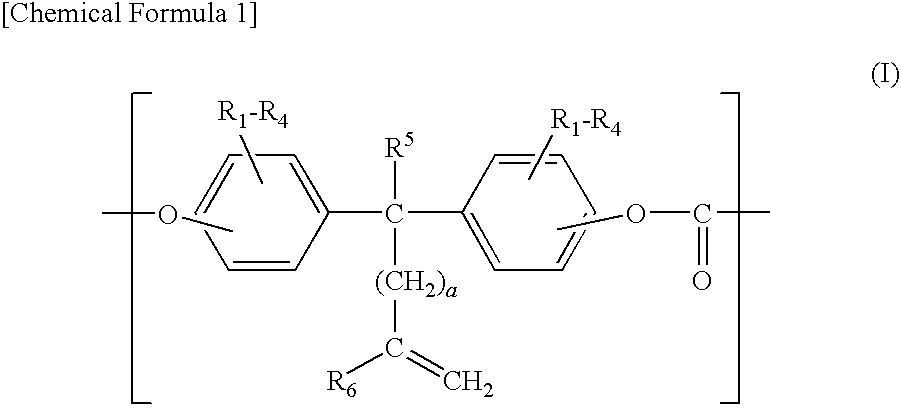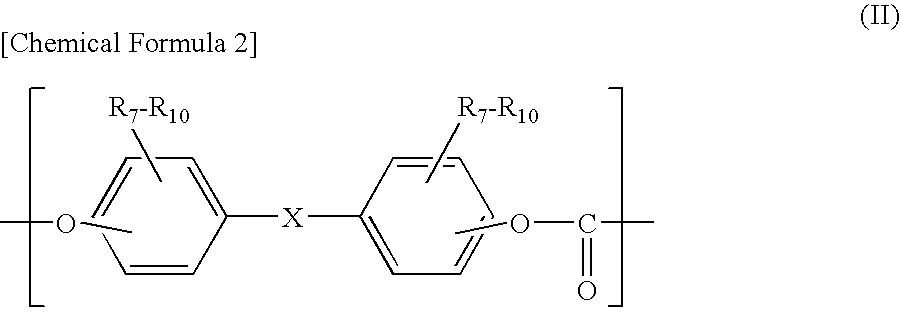Polycarbonate Resin and Electrophotographic Photosensitive Body Using Same
- Summary
- Abstract
- Description
- Claims
- Application Information
AI Technical Summary
Benefits of technology
Problems solved by technology
Method used
Image
Examples
example 1
[0102]85.8 g (0.32 mol) of 1,1-bis(4-hydroxyphenyl)cyclohexane manufactured by Honshu Chemical Industry Co., Ltd. In Japan (hereinafter, “BPZ”), 29.3 g (0.08 mol) of 1,1-bis(4-hydroxy-3-methylphenyl)-10-undecene, manufactured by API Corporation (hereinafter, “DMUDB”), and 0.1 g of hydrosulfite were dissolved into 1100 ml of 5 w / w % aqueous solution of sodium hydroxide.
[0103]Then, 500 ml of methylene chloride was added to the aqueous solution and 60 g of phosgene was blown into the solution, while stirring the solution and keeping the temperature of the solution to 15° C.
[0104]After blowing phosgene in, 1.67 g of p-t-butylphenol, manufactured by Dainippon Ink And Chemicals, Inc. (hereinafter, “PTBP”), was added as a molecular weight adjuster and the solution was stirred intensely to emulsify the reaction solution. After the emulsification, 0.04 ml of triethylamine was added and the emulsion was stirred at 20 to 25° C. for about an hour for polymerization.
[0105]After the completion of...
example 2
[0111]A polycarbonate resin was synthesized in the same manner as in Example 1 except that 73 g (0.32 mol) of 2,2-bis(4-hydroxyphenyl) propane manufactured by Mitsui Chemical, Inc. (hereinafter, “BPA”), was used in place of the BPZ. The intrinsic viscosity of the obtained polycarbonate resin was 0.58 dl / g. The obtained polymer was analyzed by means of infrared absorption spectrometry. As a result, the absorption due to a carbonyl group was observed at a position near 1,770 cm−1, and the absorption due to an ether bond was observed at a position near 1,240 cm−1, whereby it was confirmed that the polymer was a polycarbonate resin having a carbonate bond. The iodine value of the polymer was 13.8, whereby it was confirmed that an unsaturated group existed there. The synthesized polycarbonate resin was used to mold an electrophotographic photosensitive body and the performances thereof were observed in the same manner as in Example 1. The results are shown in Table 1.
example 3
[0112]A polycarbonate resin was synthesized in the same manner as in Example 1 except that the DMUDB was replaced by 27 g (0.08 mol) of 1,1-bis(4-hydroxyphenyl)-10-undecene manufactured by API Corporation (hereinafter, “UDB”), and 85.8 g of BPZ was replaced by 53.6 g (0.20 mol) of BPZ and 24.2 g (0.12 mol) of bis(4-hydroxyphenyl)ether, manufactured by Dainippon Ink And Chemicals, Inc. (hereinafter, “DHPE”). The intrinsic viscosity of the obtained polycarbonate resin was 0.50 dl / g. The obtained polymer was analyzed by means of infrared absorption spectrometry. As a result, the absorption due to a carbonyl group was observed at a position near 1,770 cm−1 and the absorption due to an ether bond was observed at a position near 1,240 cm−1, whereby it was confirmed that the polymer was a polycarbonate resin having a carbonate bond. The iodine value of the polymer was 13.4, whereby it was confirmed that an unsaturated group existed there. The synthesized polycarbonate resin was used to mol...
PUM
| Property | Measurement | Unit |
|---|---|---|
| Specific volume | aaaaa | aaaaa |
| Temperature | aaaaa | aaaaa |
| Wear resistance | aaaaa | aaaaa |
Abstract
Description
Claims
Application Information
 Login to view more
Login to view more - R&D Engineer
- R&D Manager
- IP Professional
- Industry Leading Data Capabilities
- Powerful AI technology
- Patent DNA Extraction
Browse by: Latest US Patents, China's latest patents, Technical Efficacy Thesaurus, Application Domain, Technology Topic.
© 2024 PatSnap. All rights reserved.Legal|Privacy policy|Modern Slavery Act Transparency Statement|Sitemap



